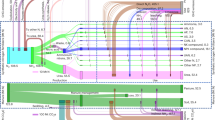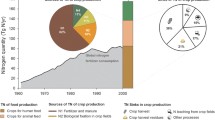Abstract
Human-induced input of fixed nitrogen (N) into the earth biosphere, primarily through combustion of fossil fuels, crop biological N-fixation and N-fertilizer use, has provided many human benefits. These benefits have not come, however, without significant cost. According to data compiled by the Food and Agriculture Organization of the United Nations, synthetic N fertilizer input into global agricultural systems increased from by approximately 430% (∼19 to ∼82 Tg N) from 1965 to 1998. During this period, global grain production, human population and global fossil fuel consumption increased about 250%, 190% and 240%, respectively. Although fuel consumption increased faster than population growth globally, land used to produce grain decreased from 0.2 to 0.12 ha/person over this 30-yr period. Grain production, however, increased 16%/person. Agricultural production increase has come through the use of new crop varieties which respond to increased N-fertilization, pesticide use, irrigation and mechanization. Even though agricultural production has increased dramatically, fertilizer N use efficiency remains relatively low. Globally fertilizer N use efficiency was approximately 50% in 1996. Since fertilizer N is not used efficiently in most parts of the world, N use in excess of crop potential utilization leads to losses to the environment through volatilization and leaching. These N losses result in N fertilization of pristine terrestrial and aquatic systems through NHx and NOydeposition and contribute to global greenhouse gases through N2O production and local elevated ozone concentrations due to NOx emission. Inefficient use of N and energy is exacerbated by the global inequity of use distribution. Some areas don't have enough while others use too much. Additionally, dietary patterns of food consumption which tend to be more inefficient, i.e. cereal-based diets compared to animal-based diets, are changing in global terms. The resulting increasing inefficiencies in N utilization in food production and in energy use lead to large-scale input of N into down wind and down stream terrestrial and aquatic systems. Increasing N-use-efficiency remains a clear goal by which to maintain food production while decreasing excessive N use and unwanted distribution in the environment.
Similar content being viewed by others
References
Aber JD, Magill A, McNulty SG, Boone RD, Nadelhoffer KJ, Downs M & Hallett R (1995) Forest biogeochemistry and primary production altered by nitrogen saturation. Wat Air Soil Pollut 85: 1665–1670
Bleken MA & Bakken LR (1997) The nitrogen cost of food production: Norwegian Society. Ambio 26: 134–142
Bouwman AF, Lee DS, Asman WAH, Dentener FJ, Van der Hoek KW & Olivier JGJ (1997) A global high-resolution emission inventory for ammonia. Global Biogeochem Cycles 51: 561–587
Broadbent FE & Carlton AB (1979) Field trials with isotopically labeled nitrogen fertilizer. In: Nielsen DR & MacDonald JG (eds) Nitrogen in the Environment, pp 1–43. Academic Press, Inc. New York
Brown LR (1999) Feeding nine billion. In: Brown LR, Flavin C & French H (eds) State of the World (1999. A Worldwatch Institute Report on Progress Toward a Sustainable Society. pp 115–132. W. Norton & Company, NY
Bumb BL & Baanante CA (1996) The role of fertilizer in sustaining food security and protecting the environment to 2020. Food, Agriculture, and the Environment Discussion Paper 17. International Food Policy Research Institute. Washington, D.C. USA. 54 pp
Conrad R (1996) Soil micro-organisms as controllers of atmospheric trace gases (H2, CO, CH4, OCS, N2O and NO. Microbiol Rev 60: 609–640
Davidson EA & Kingerlee W (1997) A global inventory of nitric oxide emissions from soils. Nutrient Cycling in Agroecosystems 48: 37–50
Delmas R, Serca D & Jambert C (1997) Global inventory of NOx sources. Nutrient cycling in Agroecosystems 48: 51–60
Downing JA, Baker JL, Diaz RJ, Prato T, Rabalais NN & Zimmerman RJ (1999) Gulf of Mexico Hypoxia: Land and Sea Interactions. Council for Agricultural Science and Technology, Task Force Report #134, Ames Iowa. 44 p
Duan S, Zhang C & Huang H (2000) Transport of dissolved inorganic nitrogen from the major rivers oto estuaries in China. Nutrient Cycling in Agroecosystems 57: 13–22
FAO, United Nations Food and Agricultural Organization (2000) FAOSTAT: Agricultural Data, are available on the world wide web: (http://www.apps.fao.org/cgi-bin/nph-db.pl? subset=agriculture)
Ferm M (1998) Atmospheric ammonia and ammonium transport in Europe and critical loads — A review. Nutrient Cycling in Agroecosystems 51: 5–17
Galloway JN, Schlesinger WH, Levy H II, Michaels A & Schnoor JL (1995) Nitrogen fixation: Anthropogenic enhancement-environmental response. Global Biogeochem. Cycles 9: 235–252
Galloway JN, Howarth RW, Michaels AF, Nixon SW, Prospero JM & Dentener FJ (1996) Nitrogen and phosphorus budgets of the North Atlantic Ocean and its watersheds Biogeochemistry 35: 3–25
Holland EA & Lamarque JF (1997) Modeling bio-atmospheric coupling of the nitrogen cycle through NOx emissions and NOy deposition. Nutrient Cycling in Agroecosystems 48: 7–24
Holland EA, Braswell BH, Lamarque JF, Townsend A, Sulzman JM, Muller JF, Dentener F, Brasseur G, Levey II H, Penner JE & Roelofs G (1997) Variations in the predicted spatial distribution of atmospheric nitrogen deposition and their impact on carbon uptake by terrestrial ecosystems. J Geophys Res (Atmospheres) 102(D13): 15849–15866
Howarth R, Billen N, Swaney G, Toronsend D, Joworski A, Lajtha N, Downing JA, Elmgren R, Caraco N, Jordan T, Berendse F, Freney J, Kudeyarov V, Murdoch P & Zhu Zhao-liang (1996) Regional nitrogen budgets and riverine N & P fluxes for the drainages to the North Atlantic Ocean: Natural and human influences. Biogeochemistry 35: 181–226
Hutchinson GL & Viets FG (1969) Nitrogen enrichment of surface water by absorption of ammonia volatilized from cattle feedlots. Science 166: 514–515
Hutchinson GL, Mosier AR & Andre CE (1982) Ammonia and amine emissions from a large cattle feedlot. J Environ Qual 11: 288–293
IFA (2000) International Fertilizer Industry Association, Nitrogen, Phosphate, Potash IFADATA Statistics. International Fertilizer Industry Association, Paris France (http://www.fertilizer.org)
IPCC (1997) In: Houghton JT, Meira Filho LG, Lim B, Trennton K, Mamaty I, Bonduki Y, Griggs DJ & Callander BA (eds) (Vol. 1–3). Revised 1996 IPCC Guidelines for National Greenhouse Gas Inventories, OECD, Paris
Legg JO & Meisinger JJ (1982) Soil Nitrogen. In: Stevenson FJ (ed) Nitrogen in Agricultural Soils, pp 503–566. Agronomy Monograph no. 22. ASA-CSSA-SSSA, Madison, WI
Ma LS (1997) Nitrogen management and environmental and crop quality. P. 3–3–321. In: Zhu ZL, Wen ZX & Freney JR (eds) Nitrogen in Soils of China, Developments in Plant and Soil Sciences 74. pp 313–321. Kluwer Academic Publishers, Dordrecht, The Netherlands
Matson PA, Naylor R & Ortiz-Monasterio I (1998) Integration of environmental, agronomic, and economic aspects of fertilizer management. Science 280: 112–115
Mosier AR, Kroeze C, Nevison C, Oenema O, Seitzinger S & Van Cleemput O (1998) Closing the global atmospheric N2O budget: nitrous oxide emissions through the agricultural nitrogen cycle. Nutrient Cycling in Agroecosystems 52: 225–248
Mosier AR, Bleken MA, Chaiwanakupt P, Ellis EC, Freney JR, Howarth RB, Matson PA, Minami K, Naylor R, Weeks KN & Zhu ZL (2001) Policy implications of human-accelerated nitrogen cycling. Biogeochemistry 52: 281–320
NRC, National Research Council (1993) Soil and Water Quality, An Agenda for Agriculture, Committee on Long-range soil and water conservation, board on agriculture, National Research Council, National Academy Press, Washington, D.C. 516 p
Policy (1999) Policy Document on Manure and Ammonia, The Netherlands. HYPERLINK http://www.minlnv.nl/international/policy/green/notutmm.html http://www.minlnv.nl/international/policy/green/notutmm.html
Prospero JM, Barrett K, Church T, Dentener F, Duce RA, Galloway JN, Levey H II, Moody J & Quinn P (1996) Atmospheric deposition of nutrients to the North Atlantic basin. Biogeochemistry 35: 27–73
Smil V (1990) Nitrogen and phosphorus. In: Turner II BL, Clark WC, Kates RW, Richards JF, Mathews JT & Meyer WB (eds) The Earth as transformed by human action, pp 423–436. Cambridge University Press, Cambridge, England
Smil V (1991) Population Growth and nitrogen: an exploration of a critical existential link. Population and Development Review 17: 569–601
Smil V (1999) Nitrogen in crop production: An account of global flows. Global Biogeochemical Cycles 13: 647–662
Steudler PA, Bowden RD, Melillo JM, & Aber JD (1989) Influence of nitrogen fertilization on methane uptake in temperate forest soils. Nature 341: 314–316
TFI (1982) The Fertilizer Handbook. The Fertilizer Institute, Washington, D.C. 274 p
USDA (United States Department of Agriculture) (1997) Agricultural Statistics 1997. United States Government Printing Office, Washington DC
Veldkamp E & Keller M (1997) Fertilizer-induced nitric oxide emissions from agricultural soils. Nutrient Cycling in Agroecosystems 48: 69–77
Vitousek PM & Matson PA (1993) Agriculture, the global nitrogen cycle, and trace gas flux. In: Oremland RS (ed) The Biogeochemistry of Global Change: Radiative Trace Gases. pp 193–208. Chapman & Hall, New Your, New York, USA
Vitousek PM, Aber J, Howarth RW, Likens GE, Matson PA, Schindler DW, Schlesinger WH & Tilman DG (1997) Human alteration of the global nitrogen cycle: Causes and Consequences. Issues in Ecology 1: 1–15
Williams EJ, Hutchinson GL & Fehsenfeld FC (1992) NOx and N2O emissions from soil. Global Biogeochem. Cycles 6: 351–388
Zhu ZL (1997) The fate and management of chemical fertilizer nitrogen in agro-ecosystems. In: Zhu ZL, Wen QX & Freney JR (eds) Nitrogen in Soils of China, Chap. 11. Kluwer Academic Publishers, Dordrecht/Boston/London pp. 201–250
Author information
Authors and Affiliations
Rights and permissions
About this article
Cite this article
Mosier, A.R. Environmental challenges associated with needed increases in global nitrogen fixation. Nutrient Cycling in Agroecosystems 63, 101–116 (2002). https://doi.org/10.1023/A:1021101423341
Issue Date:
DOI: https://doi.org/10.1023/A:1021101423341




